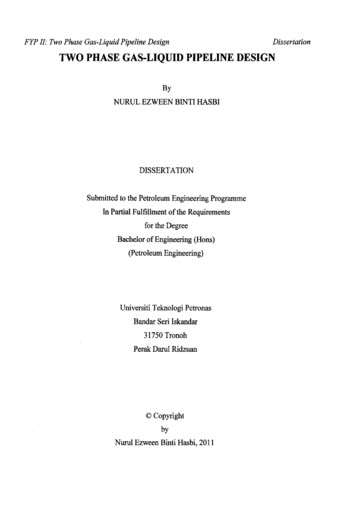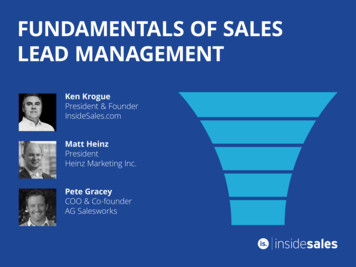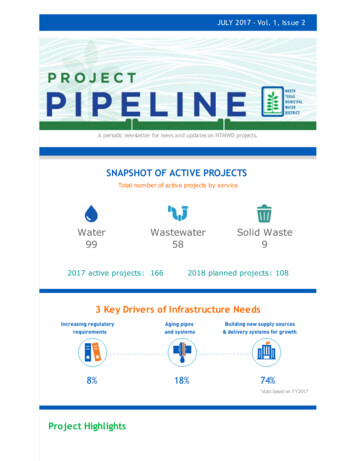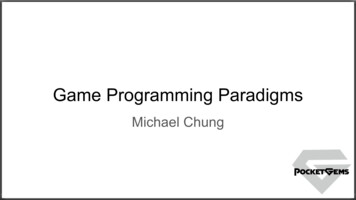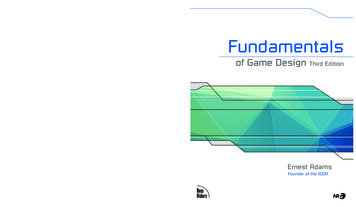
Transcription
Peter Ciszek3D Production Pipeline in Game DevelopmentBachelor’s Thesisin Information TechnologyDecember 8, 2012University of JyväskyläDepartment of Mathematical Information TechnologyJyväskylä
Author: Peter CiszekContact information: peter.m.ciszek@jyu.fiTitle: 3D Production Pipeline in Game DevelopmentTyön nimi: 3D-tuotantolinja pelikehityksessäProject: Bachelor’s Thesis in Information TechnologyPage count: 20Abstract: 3D production has grown to be major part of the digital industries suchas game and film industry. In these industries work processes can be described asproduction pipeline. Pipelines are constructed from actors working on the pipeline,their workflow and tools used to do the work. These pipelines have been usedto make processes more efficient and rational. This study attempts to explain themeaning of 3D production pipeline for game development and evaluate the processes. In this thesis, we examine the topic by examining the existing domain literature and by describing a simple model of a production pipeline.Suomenkielinen tiivistelmä: 3D-tuotanto on merkittävä osa esimerkiksi peli- jaelokuvateollisuutta, jotka ovat itsessään suuria teollisuudenaloja. Näillä aloilla työprosesseja voidaan kuvata tuotantolinjastoina. 3D-tuotantolinjastot rakentuvat sillätyöskentelevistä tekijöistä, näiden työnkuluista ja tässä työssä käytettävistä työkaluista. Tuotantolinjastoillaon tehostettu ja järkeistetty toimintaa. Tämän tutkielmantavoitteena on selvittää 3D-tuotantolinjojen merkitys pelikehitykselle ja tarkastellasiihen kuuluvaa tuotantoprosessia. Asiaa tarkastellaan tässä tutkielmassa tekemälläkatsaus alan kirjallisuuteen sekä kuvaamalla yksinkertainen malli tuotantolinjastoille.Keywords: 3D production, pipeline, 3D modeling, game developmentAvainsanat: 3D-tuotanto, linjasto, 3D-mallintaminen, pelikehitys
Contents1Introduction12Game Development2.1 Disciplines . . . . . . . . . . .2.2 Project Phases . . . . . . . . .2.3 Deliverables . . . . . . . . . .2.4 Actors in Content Production2.5 Development Process . . . . .11246633D Production3.1 3D Production in Game Development . . . . . . . . . . . . . . . . . .3.2 Actions in 3D Production . . . . . . . . . . . . . . . . . . . . . . . . .3.3 Workflows and Best Practices . . . . . . . . . . . . . . . . . . . . . . .889104Production Pipeline4.1 Need for Managing Workflows . . . . . . . . . . . . . . . . . . . . . .4.2 Managing Production using Pipelines . . . . . . . . . . . . . . . . . .4.3 Building a Pipeline . . . . . . . . . . . . . . . . . . . . . . . . . . . . .111112125Conclusion14.References.16i
1IntroductionGame industry has grown huge and shows no signs of relenting concerning the longterm growth. [15] [5] When one explores games published recently, it is obviousthat 3D production is an essential component in many products. For example in2010, a survey for indie game developers found out that 41% of game developmentactivities are art related, which includes 3D production as well [20].As a discipline, 3D production has accumulated different tools and methods toanswer the changes from rapidly progressing technology. Continuous increase incomputing performance makes it possible to create game content in new ways. [17]Production and work methods progress to answer these new ways and their requirements. [26]This paper attempts to show briefly how production pipeline is structured for3D production in game development. We will also describe the game developmentas process and take a look at its organizational structure. To understand the phenomenon and the work environment, we will discuss the actors involved in production, as well as their actions.This thesis is structured as follows. In Section 2 we go through the game development process and in Section 3 we discuss 3D production in games. Section 4describes a production pipeline, and shows how it is built and why. Finally in Section 5 we conclude.2Game DevelopmentTo understand the usage 3D production pipelines in game industry, we need totake a look at the process of creating games. Creating high-profile games in largeorganisation is challenging and requires coordination. [21] Because of this, gamedevelopment process is divided in project phases. In these phases there are formalprocedures, roles, and deliverables.2.1DisciplinesIn the early days of game development, the disciplines overlapped more becausethe work of designer, programmer, and content creator could be done by a singleperson [3]. When industry evolved and got larger, the need for domain focusedspecialists arose.These specialists are normally identified by their discipline, and those disciplines1
are defined by the work domain within the game development process. In his article The Disciplines, Albert Ferrer categorizes the game development discipline byactors: game designer, programmer, artists, producer, audio designer, quality assurance tester, and other jobs [7]. His description cover all the major disciplinesin the industry, and this taxonomy also correlates with domain literature examinedin this paper. Also note that the divisions and departments of game developmentorganisation are usually referred to by the corresponding discipline name. [18].As a compilation from literature, this paper will cover game development process from the viewpoint of four domain: business, technical, design, and content.However, this is not intended to underrate the significance of the other disciplines,but to abstract the environment for the description of 3D production pipelines. Themain reason for this taxonomy is to simplify the process to be able to focus on theactions on the pipeline.2.2Project PhasesA game development process is normally divided into three phases: pre-production,production and post-production [15]. This phasing affects the 3D content production and this relation is examined in detail in Section 3. The Desinging virtual worldsby Richard Bartle [2] describes virtual world development process with four phases:pre-production, production, roll-out and operation. In this paper, we use less gamespecific partitioning which is also more common in game development literature,such as: Basics of Game Desing by Michel E. Moore [15] and Better Game Characters byDesign by Katherine Isbister [10].In game development, the amount of work varies in different phases. Figure 1presents a simple overview of a game development process. The figure presented isadapted to the same phasing that we use in this paper. The coloured lines indicatethe required work or workforce during the process. We see that the amount of workduring the process is not static, and the work load is occasionally uneven. It shouldalso be noted that the graphs change depending of the type and magnitude of thedevelopment process.It is not uncommon for large companies to have multiple development processesunder way for different product titles. Inside these organisations, actors may bemoved between different projects, for example, to ease work load of other project orto counter project delays.In this paper, we are not interested much of the general business or managementside of the game development process. However it should be noted that schedules2
DesignerProgrammerTesterManagementConsept artist3D artist and animatorSound EngineerPre-productionProductionProof of conseptPost-productionGame ReleaseEnd of supportFigure 1: A simple overview of some game development process. [23]and business and marketing plans are produced in the pre-production phase.Pre-production phase can be seen as a overall planning and proofing phase andin this phase the overall vision of the game is communicated [2]. This phase is alsowhere the production tools is supposed to be initialized [8]. In [8] Patnode points outthat it is important to have solid and working pipeline ready before the production.In the end of pre-production phase prototype is produced and the project proceedto production phase [2].Production phase is a central part of the game development and all the requirements should be clear before it begins. When the production phase starts, it is expected that every division, team, or domain specialist know what to do, in general,and how. In production phase, it is also expected that the production tools are setup and tested for the content creators to proceed in create the expected content.The Production phase is longest part of the game development and can take severalyears. The phase ends to the release of the game. [15]Post-production is the last part of the production process, which basically meansgame support. It is normal that published games contain defects that needs to befixed by patching. [15] It is also usual that games with multiplay or online featureshave to undergo game design tweaking and content fixes after the release. Fixablecontent, for example, being a faulty animation or a sound with inadequate quality.It should also mentioned that the film industry shares the same kind of phasingwith the difference that the product is not finished by the end of the production3
phase but after the post-production [6]. This is important to keep in mind as a lot ofthe material concerning 3D production and pipelining is written for the animationfilm and visual effects industries.As a whole, however, game development is first and foremost a software development process [3]. All the practises and standards for good and stable softwaredevelopment apply. This is crucial because the technical environment and platformframe the content creation process. Basically this means that the content creator’smain function is to create the required content based on the design, while takingaccount the given technical requirements and restrictions.It should noted that the pre-production phase can also be described as a requirements gathering and these requirements are called deliverables. For example, Bartledescribes pre-production phase through these deliverables. This deliverable-basedviewpoint is fitting because when discussing the work on a pipeline, we are usuallyinterested in the requirements for the work at hand and what the output should be.2.3DeliverablesWhen working on a video game in larger organisation, one has to have an understanding on what needs to be done in one’s work domain during the developmentprocess. Some of this knowledge can be obtained from the requirements engineering subprocress of the software development process, especially when we discussabout technical side of the game development. However, when talking about gamesthere is rarely a customer or client with a specific need for a piece of software whosefunctionality can be described in detail to generate the requirements.The requirements for the game are gathered by developing a set of documents,or presentations, that, in this paper, are called deliverables. These deliverables canbe seen as something that are needed to clarify and communicate, or to deliver, therequirements. In Figure 2, we can see how the preproduction phase advances fromthe perspective of these deliverables. Sometimes these items have dependencies,which means that one needs to be completed before the production of another. Forexample, it is obvious that without reading vision document, it is challenging tocomprehend what systems need to be defined in the technical document.Not all the deliverables are mandatory in every game production, and depending how the organisation has defined them, some deliverables could contain similarmaterial to others. It should be noted that we found no reference to using pipelinedocument as deliverable, but sake of the topic of this paper we present it as one, andthis can be seen in Figure 2. Next we will go through the deliverables that will affect4
Game Design documentPRE-PRODUCTIONProof of conceptTest SuiteVision DocumentTechnical Design DocumentArt biblePipeline documentationAudio Design DocumentProject LaunchFigure 2: Pre-production phase with deliverables.the planning and building the pipeline.Vision document is a few pages long description of the feel and style of thegame. This is normally first document to be produced. Vision document has alsoother names such as pitch paper [15]. Typically, the visionary or “idea man” formalizes this document to be presented for the management or the investors [15].To contain the reference material for content creation, an art bible created duringthe process. This document is primary used to keep the content coherent [19]. Artbible is also created in pre-production phase [15] [2]. “[An art bible] is often composed primarily of concept sketches and other resources that artists can refer to asthey are working on creating various visual assets for the game” [19]. The art bible isnot typically finished during the pre-production phase as complementary materialis added during the project.Designs documents such as game design document define how the game worksand what is the gameplay and technical design document contain the requirementsfor the game engine as well as architectural description of the system [3]. Programmers and artists might assist in creating this document [15] [2]. Requirements formusic and sounds are described in the audio design document [15]. The technicaldesign document is created by programmers to define all the work in the development process for software engineering side. Development teams or departmentsmay need specific tools to be able to perform their job. These tools are also describedin the technical design document [15].Proof of concept or prototype is created before launching the project and it clarifies the workflows for the development process [15]. Pipeline documentation isfinalised after the pipeline is tested in practice, this is done most likely with the pro5
totype. Quality assurance creates document called test suite based on the designdocuments. The test suite describes what should be tested and how [15].The project deliverables present the knowledge what to do during the development processes and directs how it is done. A more detailed example of these itemscan be found at [19].2.4Actors in Content ProductionGame development requires usually professionals of different fields [3]. In this paper we call these domain professionals actors. This “actors and actions point” ofview have also been used in [22].Actors, roles, and positions are not synonyms. To avoid misconception we wouldlike to underline that an actor is substitute word for an individual, a person and ahuman being with a personality, who holds different skills and aptitudes. Role, onthe other hand, present a distinguishable set of actions that defines that role. Forexample, role of an animator may contain acts of rigging and animating. Positionsthen are more or less like job positions that can contain many roles. It should bekept in mind that organisations have developed their own work process, and thepositions and roles in different organisations vary.We will briefly go through the actors working with the pipeline. Director is anexperienced content creator or manager who manages the content creator team aswell as ensures the quality and design consistency of the content products [3]. Director also takes central part in the planning and building of the production pipeline,thus needing the experience from the workflows [21]. Designer generates requirements to the content creators by contributing to deliverables. 3D content creatoruses 3D computer graphics software to tools to create 3D content and 2D contentcreator then uses traditional and digital methods to produce digital visual assetsand textures.2.5Development ProcessIn short, game development can be described as a process that will produce a gameor a video game as its output. In this paper, we discuss products that contains 3Dcontent and thus 3D production is needed. Of course, games can also be madewithout 3D content or to have trivial amount of it.Studies and literature indicates that game development is not straightforward.Bruce R. Maxim and Benjamin Ridgway in their publication Use of InterdisciplinaryTeams in Game Development, made an incisive portrayal of game development. They6
write: “The development of computer games is labor-intensive. Modern game development requires the effort of a team of skilled professionals to integrate multimedia content with complex software. Producing high-quality software game products requires large teams to rely on high levels of communication, organization, andplanning to avoid costly delays and failures.” [14] In the context of this thesis, thisrefers especially to the integration of multimedia content, communication, organization, planning and avoiding cost, delay, and project failures. Some of these elementsare discussed by Bethke in [3] as the things that make game development difficult.In fact, having a successful development process is hard. High failure rates inproduction are extremely weary for the developers and in long run will, most likely,bring the company down [21]. The fact that in the beginning of this century onlyone in five new businesses succeed, gives a harsh image of the industry [13]. This istrue especially when we consider that factors increasing the failures have not disappeared but the volume of work and workforce have considerably increased [21].The development process starts from an idea or a vision. This idea is normallypresented or proposed to some body that is expected to fund or approve it. Thisbody or organisation possess actors with needed expertise to produce a video game.These actors, normally with the person that presented the idea, start working on thedetails of proposed idea. In short, the key figures who propose the game, producedocumentation that defines the requirements for the whole project. These details aredelivered in pre-production phase through deliverables. These deliverables consistof all the requirements and instructions that can described in that point of development. During this pre-production phase, proof of concept or prototype is producedto ensure that the production is plausible.When all the mentioned deliverables have been produced, the project is launched. In this point the actors start working on the game in teams and departmentsspecified by their discipline. Then, in the better part of the production phase, testversions of the game are done and put in the testing.The production phase ends in the release of the game. This means that the product is ready to be packaged and delivered to the customers or retail sellers. Thegame development process ends in cutting of the support in the post-productionphase. This means that no one is any longer officially working on the game in formof patches, fixes, or support service.7
33D ProductionOne major area in creating high profile games and animations is the production oftheir content. Nowadays this content is mostly created in three dimensional format.The process of producing this digital three dimensional data is here referred to as3D production.3.13D Production in Game Development3D production is significant part of game development because most of the highprofile games nowadays are, more or less, 3D games. These games are developedby large organisations that have number of studios under them and these studios,have departments and teams for 3D production. If we take a look at any gamethese organisations have produced, we can see that a large fraction of the positionscredited relate to content creation.There are various names for describing the discipline of creating 3D content.International Game Developer Association (IGDA) uses term visual desing whendescribing disciplines of game development. IGDA describes the Visual design discipline as “[the act of] analyzing, designing, and creating visual game assets.” Naming is not entirely established and new terms and categories might still be proposedin the field. The naming issue and debate is also noted in IGDA curriculum framework. [9]In this paper we use term content creation to describe the activity to create anygame content. This includes creating all the sounds, music, effects, voice acting,motion-capture, animation, models, and in-game objects and environments.As a part of content creation, 3D content creation refers to actions or work, whichresults in a product with three-dimensional data or a resource that is used with 3Ddata. With same idea, 3D content refers to a product that contains 3D data or resource. Examples of such resources include texture map and motion capture data.We define here that any material or data that cannot be sensibly used alone or without three-dimensional also data falls in this category.3D content in games is commonly created for real-time rendering [26], in whichthe deliverables and requirements for comes from the game engine, platform, andhardware. There might also be several different techniques and middlewares usedin the production that creates special requirements for the work at hand. For 3D production, these requirements normally work as guidelines and boundaries on howthe 3D content should be created. Also, engines may come with specific tools that isused to create assets or content beside the traditional 3D production. In short, the re8
quirements for 3D production in game development are defined by the technologiesused in the development processThese requirements direct what type of action are needed when 3D content iscreated. In next section we will briefly go throught some of the actions used in 3Dproduction during the game development.3.2Actions in 3D ProductionIn 3D production the product is produced through series of actions where each action adds something to the product. Each action thus builds on the previous stage,forming the process of creating the 3D product.The typical process of creating a 3D product can be desciribed as follows. First,visual assets are created by concept drawing [6], which are then are used as a concept for the modeling. Modeling is then used to create a mesh model with 3D modeling software [24]. After the model has been created, a process called sculptingcan be used to add details to the model [11]. The model is then textured, that is,visual assets are created for it, which define the color of the surface of the otherwiseblank clay statue-like model [24]. In addition, UV-mapping is used to define howthese texture maps are positioned on the model’s surface [24]. If needed, the modelcan be rigged for movement, which means creating a set of “bones” for the modeland connecting the bones to the model’s mesh [24]. Finally, animating is the actionwhere the movement for the bones is defined and recorded [24].Of the mentioned process, modeling can be seen as the main activity in 3D production. There are two main ways to create 3D models: surface modeling and solidmodeling. In the game industry, most of the assets are created as surface models.This is because they are much easier to handle by the modelers and the game engine. Solid modeling is mostly used in simulation [1] as this reflect the real objectmore accurately.The different actions in 3D production are done with software tools. Today theindustry is in a state where most of the actions needed to create the 3D product canbe done with single piece of software. Examples of this type of products include 3dsMax [24] and Maya [6] [12]. In addition, specialized tools for each action have beendeveloped. These surpass the generic tools in many cases in their productivity inthe specific action. For this reason, it is common that companies use different toolsfor different activities: one for modeling and another for sculpting etc. An exampleof this type of sculpting tool is Mudbox [11].9
3.3Workflows and Best PracticesIn general, workflow is a set of specific actions that produce an output. To understand what is an workflow in 3D production, one may simply think any set of instructions, such as tutorial, that advices how to do create specific 3D content. We canbe perceive workflow as a set of things that must be done to achieve some expectedresult. These workflows can contain reminders or tips that advice the actor to usecertain methods during the work. We call these best practices. For example, creatingmodels in modular manner by using specific modifier in the process, may be seenas best practice. In short, best practices are instructions guiding the workflow.Beside the best practices, there are also common rules for creating real-time content, such as model topology cleanness and optimization [1]. These rules are gathered from the deliverables to confine actions in the 3D production. One of these is,for example, the polycount, which defines the maximum polygonal detail for theproduct. Polycount is used to ensure that stable frame rate is achieved when models are rendered in real-time. This is because calculations need to be fast in real-timerendering to get the required smooth sixty frames per second presentation [1].The need for rules and best practices may arise on some occasions such as ingame content creation. For example, the actor responsible for this content might create surface that has two visible faces top of each other within close proximity. Andwhen the content is used in-game, the bottom face flicker through the one on thetop, even there should be several units of space between them. This phenomenon isknow as Z-fighting and it is caused by the precision limits of the Z-depth of the objects [1]. The term comes from the flickering that in a sense is caused by two surfacesfighting which one gets to be on top and drawn.One of the challenges in 3D production is the quality of the end product. If weignore the aesthetics and discuss just the technical side, it is crucial to understandthat the work field contains unexpected fault elements. The z-fighting is an exampleof such element, and content creators in long term just have learn to work aroundthe issues. This includes the ability to use the given texture side limits and to understand the different mapping techniques. [1]New workflows and best practices arise because process and work methodsevolve to answer new challenges and requirements of the industry [26]. Utilizingnew technologies and using them to streamline the workflows, is a challenge forwhole game development organisation.10
4Production PipelineManagement of the work, people, and tools is needed during the 3D production inthe game development process. The production pipeline offers an method, or aninterface, to manage, develop, and design those three as a whole, single construct.4.1Need for Managing WorkflowsWorkflow maangement is needed in content creation. As opposed to not managethe workflow in general, there are benefits for managing a workflow which we willbriefly examine in this section.First, one of the reasons is that using a workflow management will save workinghours during production [8] [12] [16]. Also, the workflow management makes thosehours more profitable. Patel argues in [16] that it makes possible expand the rangeof service offered by increasing the capacity.Stacey and Nandhakumar also argue in [22] that game development process contains temporal inner and outer working rhythms that project manager need takeinto account. Workflow management makes it possible that the people working onit may proceed in different pace, because workflow management does not specifytiming. In other words, workflow management makes it possible for multiple people work on same model in different phase of workflow, thus making it possible forthe work to happen concurrently [8].There is also a competitive reason for workflow management. When using offthe shelf product, one is tied in competition with other companies and a well managed workflow makes it possible to have a competitive advance by being able toproduce more in less time [16]. When it comes to content creation, we know that almost all the state of art tools are also available other companies in the industry andworkforce is drawn from same pool of educational bodies. In other words, betterpractices during the projects give competitive advantage.Based on the observations given in the literature, we can conclude that usinga proper workflow management strengthens the workflow and promotes synergyinside it. However, we recognize that if the utilizing the workflow managementfails, it can be hindrance for actors on the workflow management, as well as for themanagement. This simply means that management cannot be too rigid or formal.11
4.2Managing Production using PipelinesWorkflow management is usually discussed in the industry as a pipeline. Using andbuilding a pipeline is, first and foremost, a form of management. However, having apipeline does not do the management and work for you, it just makes it more clear.In [8], Jason Patnode described a pipeline simply as “. a path that assets travelto make it into a movie or game.” Tom Painter, in that same book uses descriptionsuch as: “The way we work, the tools we use, and the order in which we do thingsare known as our pipeline.” Also a definition for a pipeline were presented in [25]which was simple as: “A well-defined set of processes for achieving a certain result.”Beside the definitions in the literature, Mayur Pater describes in [16] the production pipeline as a dataflow, a workflow, and tools that facilitate those two. Hedefines the workflow as a process that regulate the work and the dataflow as regulation of data. In this case data consist of the information moving between people andthe information needed by the people. In his description tools are used to improvethese two flows. [16]Finally, most precise conceptual definition we found for the production pipelinesis defined by Dane Bettis in his thesis [4]. He describes that that production pipelineis not a structure, but m
3D production in game development. We will also describe the game development as process and take a look at its organizational structure. To understand the phe-nomenon and the work environment, we will discuss the actors involved in pro-duction, as well as their actions. This thesis is structured as follows.





